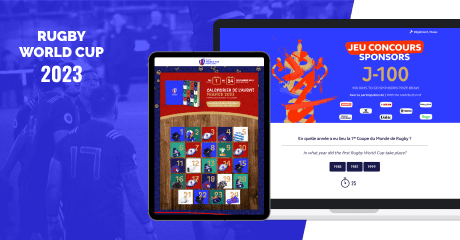Top 10 key components to a successful marketing campaign
A successful marketing campaign depends on many factors. Some of them may be outside your control but, without a doubt, some are totally manageable. To maximise your chances of success, we’ve grouped 10 key elements that you should take into account for each marketing campaign.
However, it’s essential to remember that if you don’t have enough resources in your team to follow these key elements, you can always turn to a specialised B2B digital marketing agency, which can provide valuable assistance in crafting and executing your marketing strategy effectively.
At Qualifio we believe in the power of interactive marketing and it’s ability to engage and push consumers down the consumer funnel.
There’s a whole range of formats and types of campaigns that rely on interactivity: games, contest, polls, quizzes, tests, UGC, …
And there are just as many advantages to using interactive marketing: improving brand awareness, boosting audience engagement, building audience loyalty, …
CURIOUS TO FIND OUT MORE ABOUT INTERACTIVE MARKETING? IT’S ALL OVER HERE
1. Clearly define your target audience
The first thing you need to think about for a successful marketing campaign is: who are you targeting? You have to ensure each campaign you make is aimed at your ideal customer or client. “Talk to everyone and you’ll sell to no one.”
How to define your target?
- First, you need to ask yourself what is the purpose of your product or your service? Which problem is your product or service trying to solve?
- Second, you need to find who your product or service will help. Basically, you need to define your personas, a.k.a your ideal customer or client. There are no predefined rules for that, you can include as much criteria as you want, as long as it helps you have a clear idea of who you are talking to. For example, some criteria you could focus on are: the age and gender, the profession, the geolocation, the financial situation, the family status, the interests, etc. Tip: to better identify segments of your audience, collect audience data with online tools!
- Once you’ve clearly defined your audience, the last question you need to ask yourself is: will these people pay for your product or service? If not… revise your offer or your target!
2. Establish your goals
Before jumping in, you must figure out what your expectations are for this marketing campaign? What do you want to accomplish? What is its purpose? Do you want to generate leads, close new customers, re-engage existing ones (and have them interact with your brand), increase your visibility, increase sales of a particular product or service, drive more traffic to your website…?
You need to set realistic and tangible goals for your marketing campaign before you even begin. That way, you will be able to assess whether it was a success. In order to do that, you will also need to set Key Performance Indicators (KPIs) related to your goals. The what? An example is worth a thousand words: if your goal is to increase your newsletter subscribers, your KPI will be to reach the milestone of 1,000 subscribers, for example. More info about the KPIs here.
3. Define your target
In order to meet your goals, you need to know how much you’re ready to invest in your marketing efforts. Think in advance about all the costs you’ll need to include, such as the actual creation of the campaign, the internal or external resources needed for it, the timing, the promotion (which we will talk about later), etc.
4. Create targeted content
Once you have your target audience and your goals in mind, you can start creating your campaign. Constantly coming up with original campaigns ideas is not that easy. If you lack imagination, a solution is to identify the performing campaigns of your popular competitors. This will give you a good idea of what your audience may like. Never copy a competitor’s work; instead, use it as a good start for your own campaign and make yours better by adding your own creativity layer, your own voice and your own value proposition.
Looking for another option? Go to the “inspiration” section of our blog and get inspired with campaign ideas for summer, back to school, halloween, etc. ? Better, download our editorial calendar with the list of the most powerful marketing opportunities. Our downloadable and printable editorial calendar will help you track your content creation for the year ahead.
5. Engage with your audience
Make your audience want to participate in your campaign. The easiest way is to add a special prize, preferably related to your business (to avoid cheating or spam), to attract more participants. You can also invest in visuals like videos, pictures, infographics that catch more the attention. Another way is to use gamification. Everyone likes to play. And the key is to offer moments of fun and interaction to your audience. By proposing to your audience to take part in a quiz, a memory game, a jackpot or another playful campaign, you will engage them better and increase your participation rate.
6. Offer something valuable
Not everybody’s going to buy your product or use your service after seeing one of your campaigns. Use each campaign as a way to showcase your products (and how it will solve your audience’s problem) or your expertise and help prospects get to know you better. The call-to-action plays a major role here. Give them something that’s free, very valuable and unique (a video, a case study, an e-book, an interactive online brochure, a free consultation, etc.) to differentiate yourself from the competition and give them also the opportunity to ask for more information.
7. Up your chances of going viral
Make your campaign easy to share. If your campaign isn’t designed to be shared, you’re limiting its potential. Here are some ideas:
- For a successful marketing campaign, has to be easy to share it on the various social media channels (Facebook, Twitter, Pinterest, LinkedIn, etc.);
- Encourage participants to share your campaign on their social media profiles by rewarding them with an additional chance to win;
- Participants need to be able to easily share your campaign with their friends and invite them to participate;
- To spark the dialogue around a campaign, let your audience comment, take pictures, shoot videos, vote, etc.
8. Distribute and promote your campaign
Now that you’ve created your marketing campaign, it’s time to promote it. You need first to choose the right canal to reach your target audience. It doesn’t’ make any sense to create a fantastic campaign if nobody is seeing it. There are tons of ways to diffuse your campaign:
- Share it on social media;
- Send an email to your subscribers notifying them of your marketing campaigns or include an image that promotes your campaigns in your newsletter;
- Publish a press release;
- Spend a bit of money on advertising (Facebook or Linkedin ads, promoted tweets, Google AdWords, radio ads, etc.);
- Update your Facebook cover or profile photo, your Instagram bio with a link to your campaign;
- Etc.
Want to find out more? We’re explaining you how to boost your content marketing in this article 😉
9. Measure your ROI
As mentioned in point #2, after each marketing campaign conducted, you need to assess its efficiency. What’s the point of implementing campaigns if you are not tracking results? Ask yourself questions guided by your objectives: how many new subscribers did you get? How many leads came through your campaign? Did your call-to-action fulfil its objective? Collect, analyse and consider the results of all this data. This will help you adjust your campaign’s creative elements or budget and create more relevant marketing campaigns afterwards. The data allows you to test, optimize, learn and react quickly with objectives measures.
To measure your ROI, you can use built-in measurement tools. A lot of digital tools you can find these days provide you with metrics and figures for marketing campaigns, which is a good place to start. For example, Qualifio offers a performing statistics module to help you to assess and track the success of your marketing campaigns. For more information on how to calculate your ROI, check this article.
10. Keep it going
Now that you’ve entered a relationship with new prospects, you can begin nurturing those leads. Track the channels through which they came to you, send them relevant information, share more about your business, etc. And to do so, you need to keep collecting data to better know your users and deliver personalised contents.
Continue the dialogue until you become known and trusted. When the time will come for them to buy, they will think about you first! Of course it’s not something you do in five minutes but if you respect the elements described above, your results will certainly be positive.
Want to become a better digital marketer and create effective marketing campaigns?







